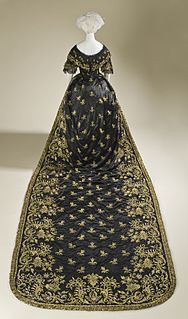 W
WAcademic dress is a traditional form of clothing for academic settings, mainly tertiary education, worn mainly by those who have obtained a university degree, or hold a status that entitles them to assume them. It is also known as academical dress, academicals, and, in the United States, as academic regalia.
 W
WThe academic dress of the United Kingdom and Ireland has a long history and has influenced the academic dress of America and beyond. The academic square cap was invented in the UK as well as the hood which developed from the lay dress of the medieval period.
 W
WAcademic regalia in the United States has a history going back to the colonial colleges era. It has been most influenced by the academic dress traditions of Europe. There is an Inter-Collegiate Code that sets out a detailed uniform scheme of academic regalia that is voluntarily followed by many, though not all institutions entirely adhere to it.
 W
WAn abolla was a cloak-like garment worn by ancient Greeks and Romans. Nonius Marcellus quotes a passage of Varro to show that it was a garment worn by soldiers, and thus opposed to the toga.
 W
WThe wearing of academic scarves is a tradition found at many colleges and universities in English-speaking countries, and particularly in the United Kingdom and Ireland. Sets of two or more coloured stripes have traditionally been used as part of the distinctive visual identity of these institutions. The scarves are usually made of Saxony wool and traditionally 6 feet long.
 W
WThe beca is worn on the breast and shoulder, over the doublet. The colors of the beca and the coat of arms embroidered on it identify the university and school or faculty that the tuno belongs to. The beca is given to the tuno by his companions when they consider that he has enough experience, and is fit to represent his University Tuna and, by extension, his/her university.
 W
WThe Bishop Andrewes cap is a recent reinvention of the ancient style of academic cap as part of academic dress before it developed into the modern mortarboard as it is known today. The cap is named after Bishop Lancelot Andrewes who may or may not have worn this style of cap at all.
 W
WThe bluecoat is a style of dress code, traditionally worn in Bluecoat schools.
 W
WThe Burgon Society is a learned society and educational charity for the study and research of academic dress. The society was founded in 2000 and is named after John William Burgon (1813–1888) from whom the Burgon shape academic hood takes its name. Its current president is Graham Zellick, CBE, QC, former Vice-Chancellor of the University of London. His predecessors were James P.S. Thomson, former Master of London Charterhouse (2011–16) and the organist John Birch.
 W
WA chimere is a garment worn by Anglican bishops in choir dress, and, formally as part of academic dress.
 W
WThe academic dress of China has a long history. The ancient dress is based on the robes of officialdom and the 'degrees' were earned through the imperial civil service examinations, while the modern dress is partially influenced by the Western academic dress. Ancient China consisted of official dress. Official dress was used to represent an official in society and a scholar at the same time.
 W
WCouleur is the expression used in Central European Studentenverbindungen for the various headgear and distinctive ribbons worn by members of these student societies.
 W
WA doctoral hat is a major part of Nordic academic dress of Ph.D. recipients in Finland and Sweden and differs from the square academic cap found in other parts of the world. It is a silken top hat with a straight brim, although the hats of Finnish Doctors of Science (Technology) have an up-turned brim. Generally the colour of the hat is black, although a few faculties use coloured doctoral hats. On the front, the hat has a gold-coloured metallic emblem of the granting university or faculty. The hat is awarded in a solemn graduation ceremony.
 W
WIn Danish, Norwegian, and Swedish academia, a doctoral ring may be bestowed upon the conferral of a doctorate.
 W
WEde & Ravenscroft are the oldest tailors in London, established in 1689. They have two London premises, in Chancery Lane and Burlington Gardens, very close to the famous Savile Row. They make, sell and hire out legal gowns and wigs, clerical dress, civic and municipal robes, academic dress and other ceremonial and formal dress, and have shops in Oxford, Cambridge and Edinburgh.
 W
WA gown, from the Saxon word, gunna, is a usually loose outer garment from knee- to full-length worn by men and women in Europe from the Early Middle Ages to the 17th century, and continuing today in certain professions; later, gown was applied to any full-length woman's garment consisting of a bodice and attached skirt. A long, loosely fitted gown called a Banyan was worn by men in the 18th century as an informal coat.
 W
WAn honor cord is a token consisting of twisted cords with tassels on either end awarded to members of honor societies or for various academic and non-academic achievements, awards, or honors. Usually, cords come in pairs with a knot in the middle to hold them together. Sometimes sashes, stoles, or medallions are given in place of cords. They are most often worn at academic ceremonies and functions. With cap and gown, and (sometimes) the hood, high school or university degree candidates have worn these cords at the discretion of the educational institution, but they are not usually worn with academic regalia after the academic year in which the honor was awarded. Unlike hoods and stoles, by tradition more than one cord may be worn at the same time.
 W
WA hood is a kind of headgear that covers most of the head and neck, and sometimes the face. Hoods that cover mainly the sides and top of the head, and leave the face mostly or partly open may be worn for protection from the environment, for fashion, as a form of traditional dress or uniform, or in the case of knights, an armoured hood is used for protection against bladed weapons. In some cases, hoods are used to prevent the wearer from seeing where they are going. Hoods with eye holes may be used for religious purposes to prevent the wearer from being seen. In the case of Ku Klux Klan members, terrorists, or criminals such as robbers, a hood with eye holes helps prevent identification.
 W
WThe khrui is a light outer garment worn as a gown or robe in certain ceremonial settings in Thailand. It is long-sleeved and open at the front, and is made of a sheer or mesh fabric, lined with a band of satin, felt or other material, and may be exquisitely embroidered. Dating from at least the 17th century, it was originally worn only in the royal court, but nowadays is most recognisable as the form of academic dress employed by many universities, especially Chulalongkorn University.
 W
WA liripipe is an element of clothing, the tail of a hood or cloak, or a long-tailed hood. The modern-day liripipe appears on the hoods of academic dress.
 W
WA robe is a loose-fitting outer garment. Unlike garments described as capes or cloaks, robes usually have sleeves. The English word robe derives from Middle English robe ("garment"), borrowed from Old French robe, itself taken from the Frankish word *rouba, and is related to the word rob.
 W
WGeorge Wenham Shaw was a biologist and leading British expert on academic dress. He designed the academic robes for the University of Bath UK, Trent University, Ontario and Universidad Simón Bolívar, Venezuela.
 W
WThe square academic cap, graduate cap, cap, mortarboard or Oxford cap, is an item of academic dress consisting of a horizontal square board fixed upon a skull-cap, with a tassel attached to the centre. In the UK and the US, it is commonly referred to informally in conjunction with an academic gown as a "cap and gown". It is also sometimes termed a square, trencher, or corner-cap. The adjective academical is also used.
 W
WAn academic stole is a vestment used by various organizations to denote academic achievement. Its use includes membership of a professional organization, a high school valedictorian award, and adorns the academic regalia representing some university and college courses.
 W
WStudent boilersuit are boilersuits widely used for specific events at universities and polytechnics in Sweden, Finland, and Canada. Typically, the suits are procured by the student associations of faculties or programmes. At the major Swedish universities the use of boilersuits is limited to engineering students, but their use has spread to students in other fields at some of the smaller university colleges. In Finland, boilersuits have also been foremost identified with engineering students, but see extensive use in all of the student organizations of Finnish institutions of higher learning, such as University of Helsinki and Aalto University.
 W
WIn various European countries, student caps of different types are, or have been, worn either as a marker of a common identity, as is the case in the Nordic countries, or to identify the wearer as a member of a smaller body within the larger group of students, as is the case with the caps worn by members of German Studentenverbindungen, or student groups in Belgium.
 W
WA toque is a type of hat with a narrow brim or no brim at all.
 W
WIn clothing, a train describes the long back portion of a robe, coat, cloak, skirt, overskirt, or dress that trails behind the wearer.
 W
WA Tudor bonnet is a traditional soft-crowned, round-brimmed cap, with a tassel hanging from a cord encircling the hat. As the name suggests, the Tudor bonnet was popularly worn in England and elsewhere during Tudor times.
 W
WUndergraduate gowns are a notable feature of academic dress for students at the ancient universities in Scotland.
 W
WA white coat, also known as a laboratory coat or lab coat, is a knee-length overcoat or smock worn by professionals in the medical field or by those involved in laboratory work. The coat protects their street clothes and also serves as a simple uniform. The garment is made from white or light-colored cotton, linen, or cotton polyester blend, allowing it to be washed at high temperature and making it easy to see if it is clean.